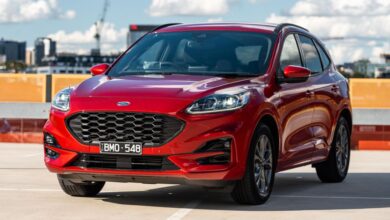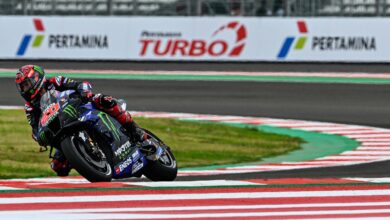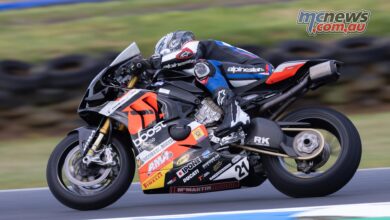Review: Riding the stunning Yamaha XSR900 GP retro sportbike
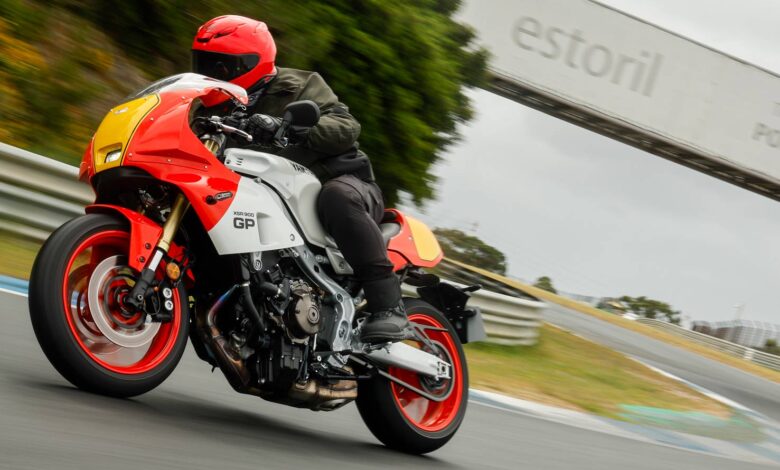
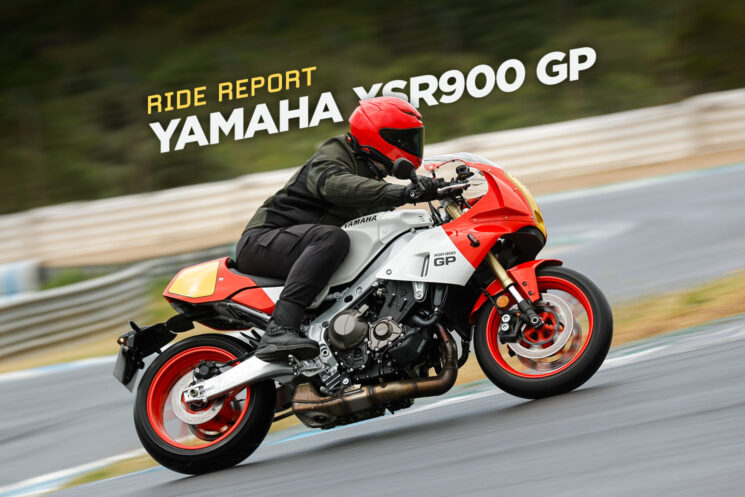
Some motorcycles beg to be ridden in anger. Others drip with nostalgia. If you draw a Venn diagram of those two paradigms, you’ll find the Yamaha XSR900 GP smack dab in the middle of the intersection.
The Yamaha XSR900 GP just about melted our servers (and lit up our comments section) when it first broke cover in October of last year. Drawing inspiration from Yamaha’s illustrious racing heritage, it’s a homage to iconic bikes like the Yamaha TZR250 and YZR500 OW01, reimagined on the modern, three-cylinder XSR900 platform. And its retro sportbike underpinnings make it one of the most striking factory bikes currently on the market.

But does the Yamaha XSR900 GP look as good in the flesh as it does in photos? Is it all show and no go? And what’s the Portuguese coast like this time of year? I headed to the picture-perfect coastal town of Ericeira, on Yamaha’s invitation, to find out.
Between consuming disproportionate amounts of fresh seafood, exquisite wines, and sublime desserts, my peers and I sampled some of the region’s best backroads—and even squeezed in a photo op on the famed Estoril race circuit. But we also rubbed shoulders with the people behind the XSR900 GP’s development, gaining insight into its compelling backstory.
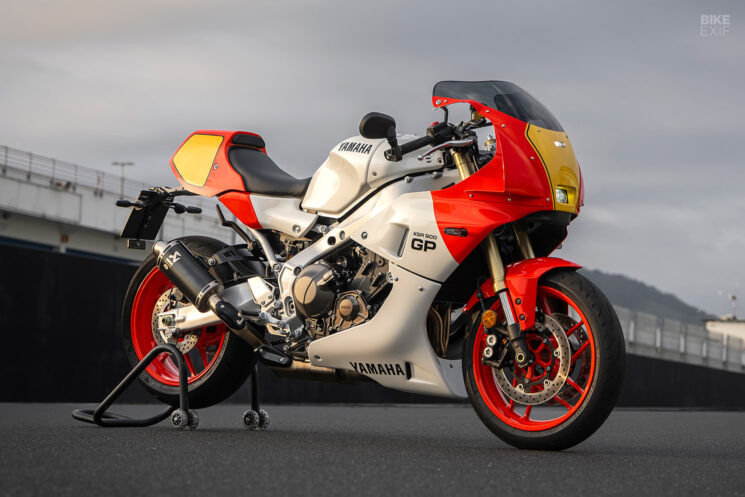
If the sport heritage motorcycle segment is a niche, then the Yamaha XSR900 GP occupies a niche within that niche, by prioritizing performance without sacrificing style. It’s a tiny needle to thread, making the XSR900 GP arguably one of the gutsiest OEM releases in recent years.
The story starts eight years ago, when Yamaha product manager, James McCombe, sat down for his first interview with the Japanese marque. Asked what he would create, given the opportunity, his response was a variant of the XSR platform that would represent Yamaha’s racing lineage, and legitimize the sport side of the sport heritage tag. But turning that concept into a fully homologated motorcycle that, while it does make compromises makes few compromises, was a tumultuous journey.
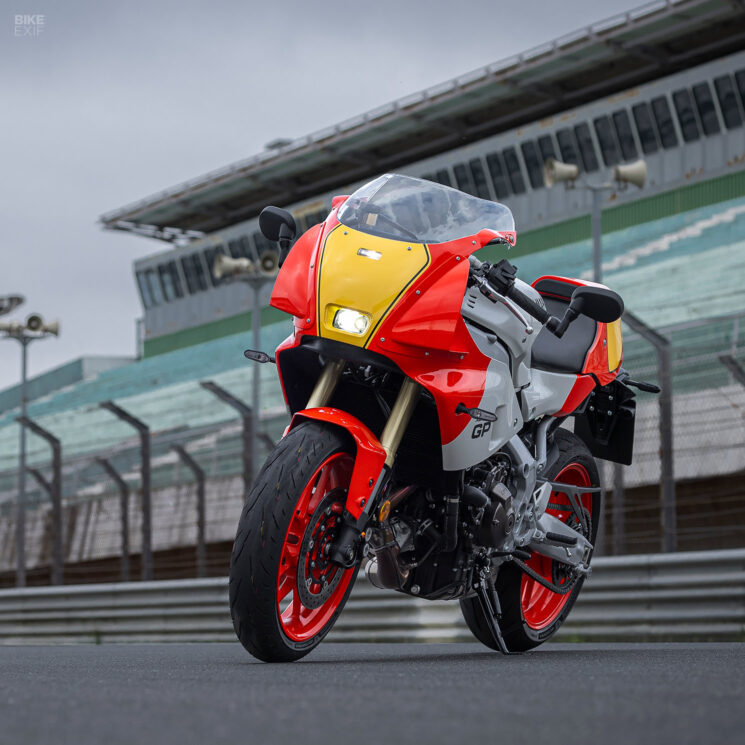
The XSR900 GP project stalled twice and survived a global pandemic that limited contact between Yamaha’s global team, which is split between Europe and Japan. Workarounds were needed—like signing off the design using 3D renders instead of the tried and true modeling clay method. And then there was the usual internal tension that comes from trying to color outside the lines without blowing the budget.
It’s easy to forget that factory motorcycles take an inordinate time to develop, and that they are conceived, designed, and engineered by real humans. Product managers arguably have the toughest job of all. They need to look into a non-existent crystal ball to predict what the industry zeitgeist will be years down the line, and then they need to rally a team around them and convince the powers that be that their idea is a good one.
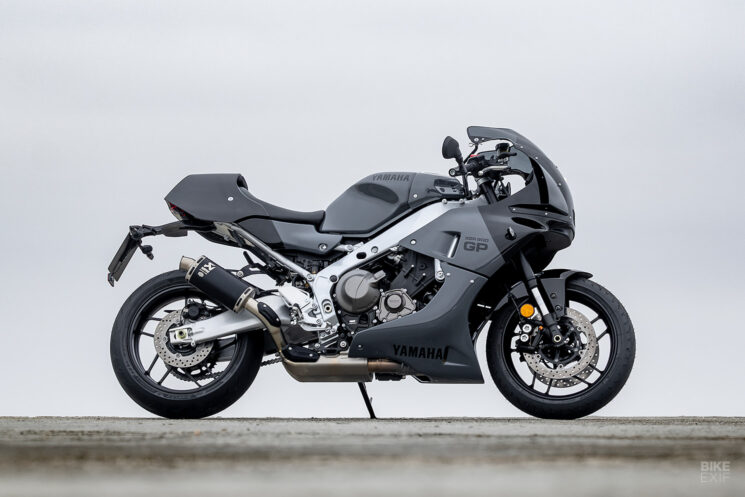
It takes vision and moxie to bring a bike like the Yamaha XSR900 GP to market. The fact that this bike has hit the scene just as the 80s and 90s sportbike revival is reaching fever pitch is a testament to the tenacity of Mr McCombe and the designers, engineers, and test riders who worked on the project.
The GP hits all the right notes, evoking motorcycle racing’s golden years while nailing the balance between modern and retro. My brief time in Portugal was fraught with moody weather, but even so, the bike shimmered in the light of day. Every detail that had struck me when I first saw photos of it was now cranked up to eleven (twelve, when the sun finally poked through the clouds).
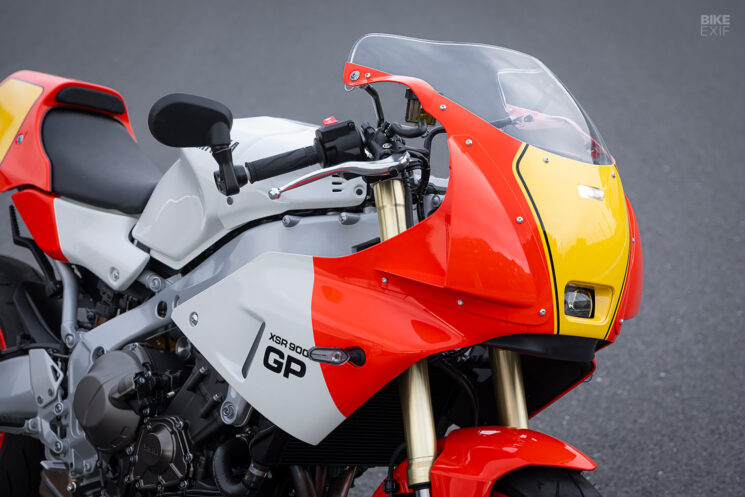
Adapted from the ‘standard’ Yamaha XSR900, the GP model trades the platform’s black frame paint for a silver finish that highlights the bike’s Deltabox-like chassis. Fresh bodywork sits up top; a half-fairing with bolt-on wind deflectors, new side panels, and a boxy rear cowl that covers the pillion seat. Those pieces create a faultless silhouette, making the GP’s heritage undeniable.
The XSR900 GP’s flagship ‘Legend Red’ livery [above] pops hard and begs closer inspection. The white bits are ever so slightly silvery, the red bits have a hint of orange in them, and the yellow number boards boldly recall the Yamaha racers of yesteryear. (Even the brake rotor carriers are painted, to disguise them against the red wheels.)
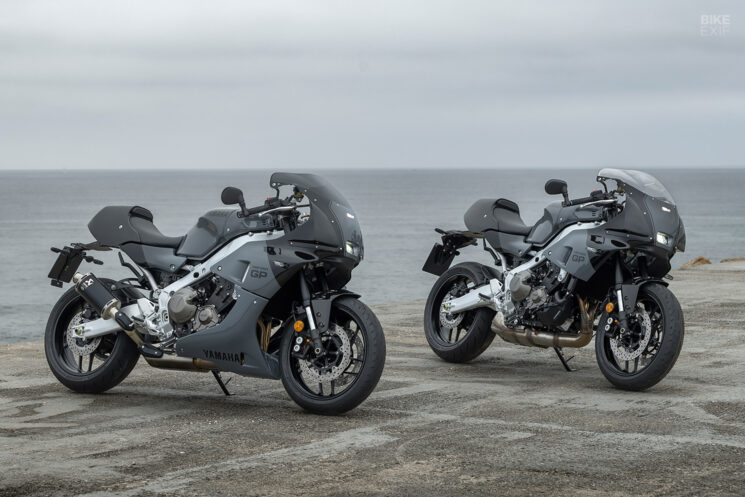
The aptly named ‘Power Grey’ colorway [above] is somehow both more subdued and bolder than its livelier counterpart. Wrapped in swathes of grey and black, it foregoes the throwback racer vibe for a brooding look that would killer under Tokyo’s neon lights. For my money, I’d be hard-pressed to pick between the two.
The bike boasts a high level of fit and finish, and nowhere is this represented better than in the minutiae of its cockpit. From the rider’s position, the perfectly proportioned fairing stays and TZ250-inspired beta pins that hold the fairing in place transport you right back to the 80s. (Yamaha would have used the same pins on the lower fairing attachment points, but certain European regulations demand that at least some of the bodywork fasteners require tools to remove.)
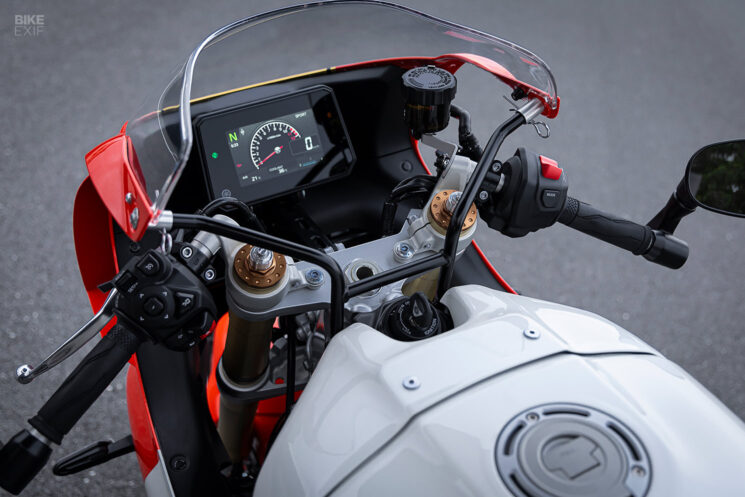
A drilled strut extends from the center of the top yoke to the front of the fairing, where the bike’s contemporary TFT display lurks quietly. All of the wires are neatly wrapped together, and anchored to a purpose-built bracket that attaches discreetly to the triple clamp. Small bulges along the top edge of the fairing accommodate the clip-ons at full steering lock; the bars are not adjustable, presumably to avoid any clearance issues.
Yamaha loses half a point for one tiny unsightly connector that was exposed on the bike I rode on the day. And although I can accept the need for modern switchgear that can simultaneously operate the bike and navigate its dashboard menus, I can’t tolerate the new turn signal button that Yamaha has debuted on the XSR900 GP. It’s a clunky button that’s supposed to make life easier with short- and long-burst functions and an auto-canceling feature, but it feels awkward to use and never quite works right.
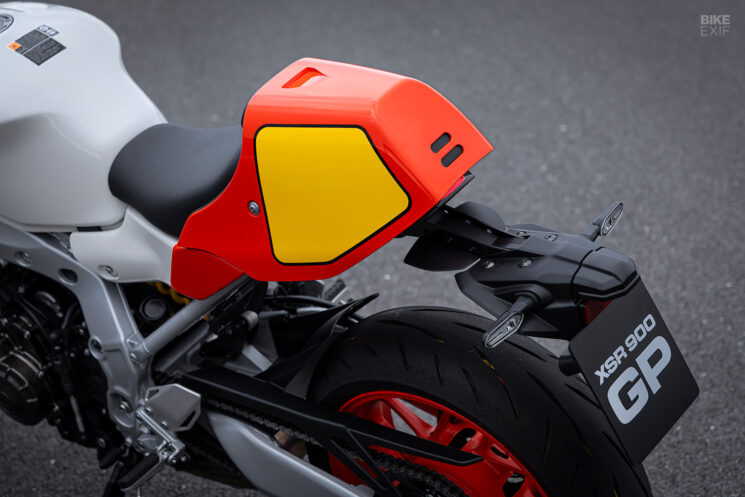
The rest of the XSR900 GP’s accouterments are executed with panache. The LED turn signals are slim and unobtrusive, and the tail bracket manages to extend the license plate to where regulations require, while also providing a little extra rear wheel splash protection. The passenger pegs also use a unique design that makes them less visible than most setups.
Not wanting to ruin the bike’s race-inspired visage with a big headlight, Yamaha’s team designed a slim headlight housing that mimics an air vent, then packed an ultra-bright LED headlight in there. At the opposite end of the bike, what I initially thought were twin taillights in the bum stop are just slits that mimic the slim warning lights on track bikes. The real taillight, taken directly from the regular XSR900, is hidden lower down—but it’s neat enough not to disrupt the overall design.
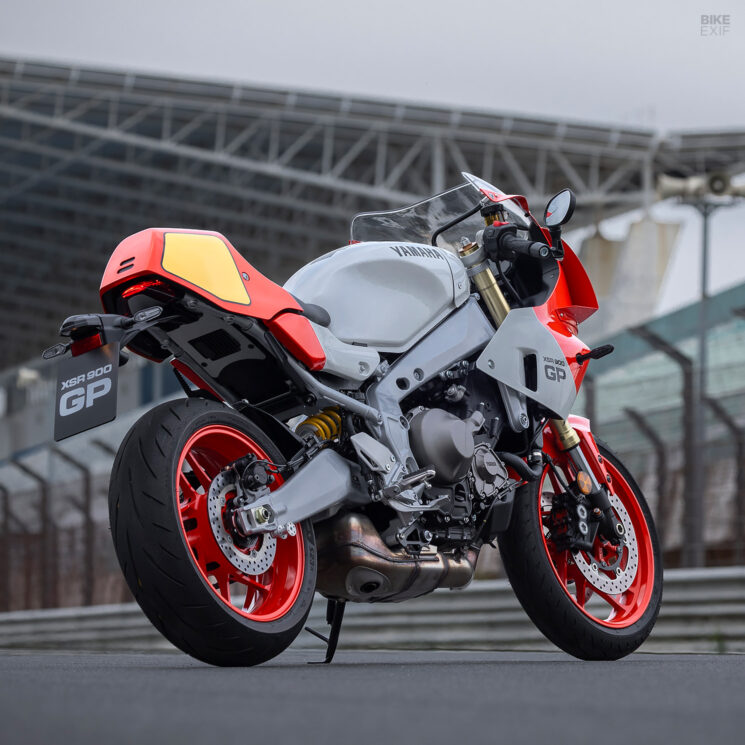
All these considerations make the XSR900 GP’s one aesthetic misstep almost unforgivable. Keeping the bike’s development costs reasonable meant leaving some of the ‘base’ model’s parts untouched. While that worked out well for parts like the taillight, bar-end mirrors, and wheels, the XSR900’s exhaust is an eyesore on the GP.
A part of me likes the brutality of the whole unit and the race prototype effect that it invokes—particularly when you notice how tidy the welds are. But it’s hard to deny that it looks like someone hacked the bike’s silencer off and left the lardy catalytic convertor behind. And it only gets worse when you see the bike with the optional Akrapovič exhaust system on, and realize how much better it looks.
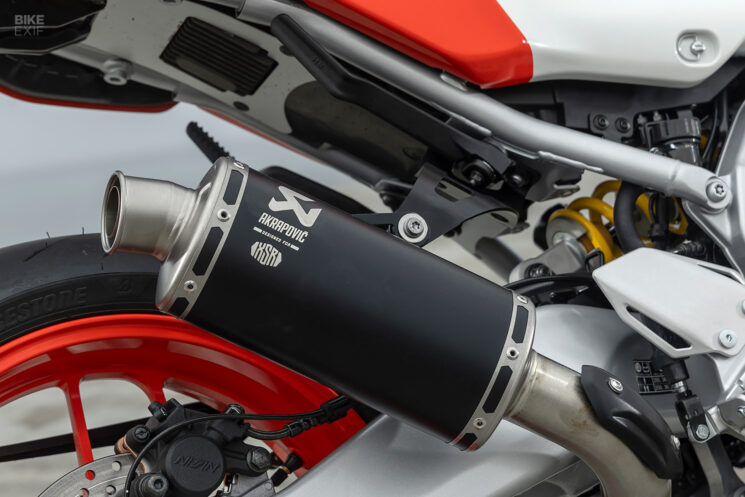
The Akrapovič system trades the boxy stock part for a slimmer underslung collector and a stubby muffler that sits exactly where you’d expect it to on a bike of this ilk. It’s part of the bike’s optional ‘race’ kit, which also includes fairing lowers, a tinted windscreen, and a slimmer tail tidy. (No doubt, many buyers will happily fork out for the added swagger.)
Behind the truckloads of sex appeal lies one of the best engines currently on the market; Yamaha’s utterly brilliant 890 cc triple-cylinder ‘CP3’ crossplane engine, which is now Euro5+ compliant. It makes 117.3 hp at 10,000 rpm and 93 Nm of torque at 7,000 rpm, but those numbers are ultimately irrelevant. Because where the XSR900 GP’s engine truly shines, is in its impeccable power delivery.

The link between the throttle and the rear wheel is seamless, the response is visceral, and the amount of usable mid-range torque and power is astounding. It all makes for a rider’s motorcycle—a bike that can pull hard from low down in the rev range if it needs to and howls when you properly open it up. It also makes for a bike that can handle a squirt of power out of a corner without getting bent out of shape.
Despite how the exhaust looks, the XSR still emits a guttural growl—partly thanks to its new intake design, and partly because it is a triple, after all. And while this engine usually looks busy and overbuilt in the more naked XSR900, it actually serves the factory race prototype vibe of the GP model.
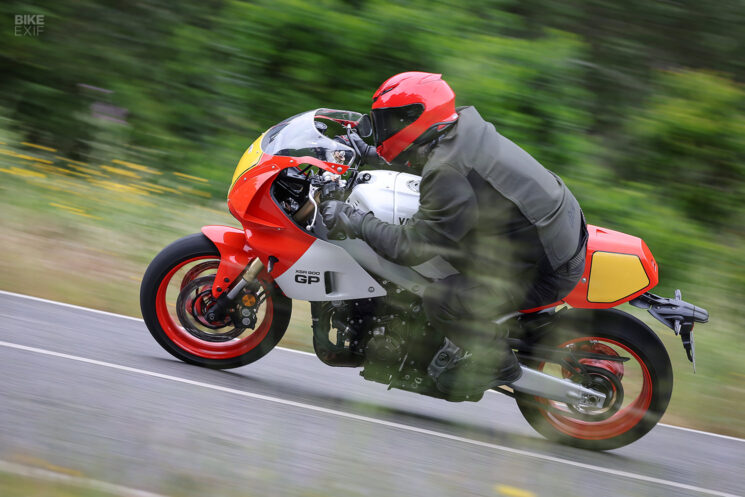
Yamaha struck gold with the XSR900 GP’s electronics package too. For starters, the onboard rider modes, traction control, ABS, and other electronic aids operate in a helpful, rather than obtrusive, way, guided by a six-axis IMU (as has become the industry standard). Flicking between the rain, road, and sport modes, the behavior change is tangible, but the bike’s sublime throttle feel is never sacrificed.
Hooligans and wheelie fiends will no doubt want to dive into the bike’s customizable rider modes to dial back the traction and anti-wheelie control, but I found the standard settings more than ample for a day spent sashaying through the Portuguese countryside’s tree-lined twisties.
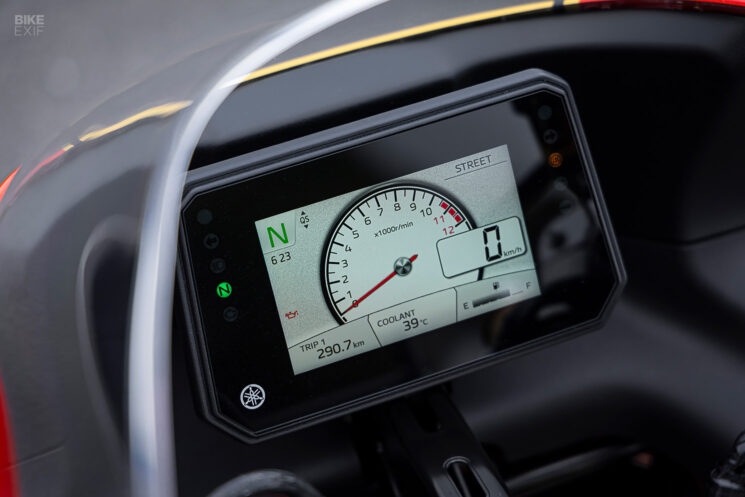
The TFT display itself is pretty neat too. It hosts a smorgasbord of smartphone connectivity features, including navigation, but I felt it worked best when I just left it on the ‘home’ screen, which uses a design unique to the GP model. Centered around an analog-style tachometer, it distributes the rest of the information around the screen in diminishing levels of priority, making it easy to follow.
The other big update on the XSR900 GP is its revised quick-shifter. Quick-shift systems are notorious for only working well at certain spots in the rev range, but this system is far more forgiving. Between the shifter, and the updates the the bike’s six-speed transmission, the GP never missed a shift, no matter how ham-fisted I was with it.
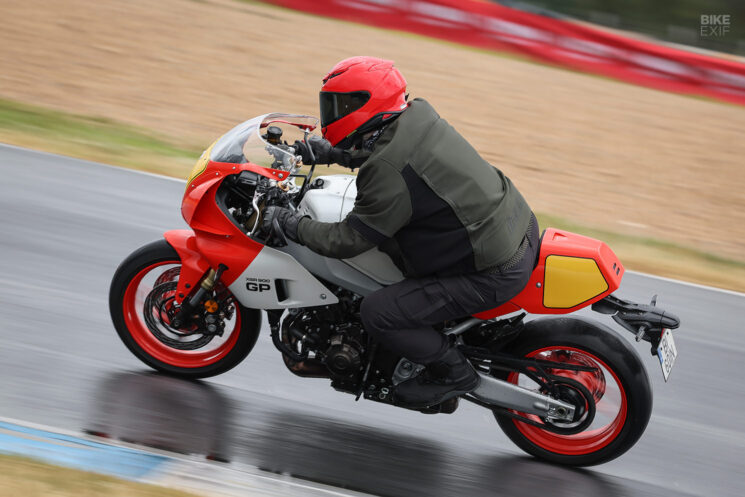
The new system also allows for upshifts during deceleration and downshifts during acceleration—which sounds pointless, until you need to kick down a gear to overtake a truck, and don’t want to let go of the throttle.
Backing up the XSR900 GP’s peach of a motor are several chassis and geometry changes. The clip-ons and rear-set pegs are obvious deviations from the standard XSR formula. They pitch you forward, but stop shy of the more aggressive riding position found on bikes like the Yamaha R7.
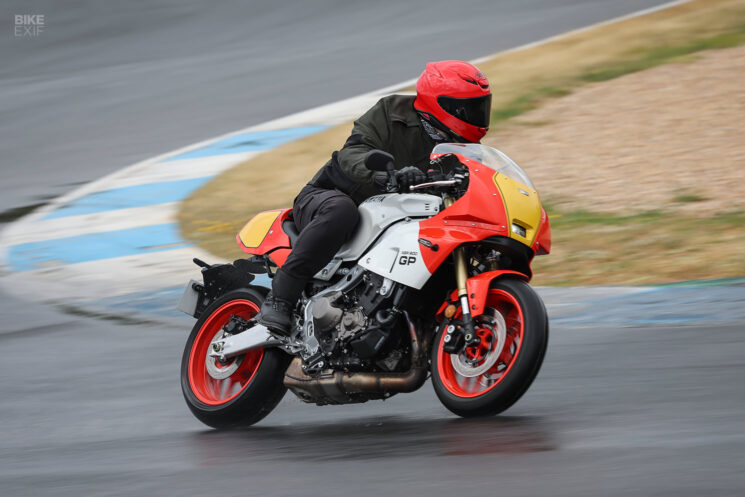
Yamaha opted for this particular layout because they’re well aware that the XSR900 GP’s target customer isn’t looking for an outright superbike (and the accompanying chiropractor bills). I can confirm that the GP is indeed more comfortable than your average superbike, but I can also confirm that, by the end of our ride, my wrists and legs were nagging me.
My butt, however, was fine; the XSR900 GP’s seat is surprisingly well-padded. And if I’m being totally fair, at 1.83 m [6 foot] tall and tipping the scales at a svelte 139 kilos [306 pounds], I was more comfortable on the GP than I thought I would be. I was also surprised at how well the windscreen mitigated turbulence—even though a Yamaha staffer later confessed that it was designed for style and not aerodynamics.
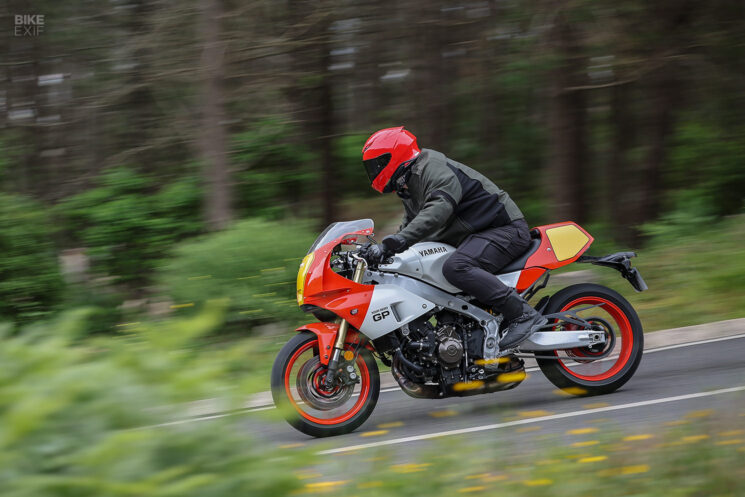
It was no fun around town (where I used the bike’s onboard cruise control to adhere to speed limits while giving my wrists a rest), but once I got it up to speed it felt more compliant. It’s unlikely that I’d pick it for touring or commuting, but as a weekend warrior, it works, and Yamaha isn’t advertising it as anything else.
The changes to the XSR900 GP’s setup go beyond just the controls. Yamaha tuned the chassis to compensate for the extra load that the riding position places on the front of the bike, by revising the engine mounting brackets. This is also the only bike among its stablemates (the XSR900 and MT-09) to feature an aluminum steering shaft.
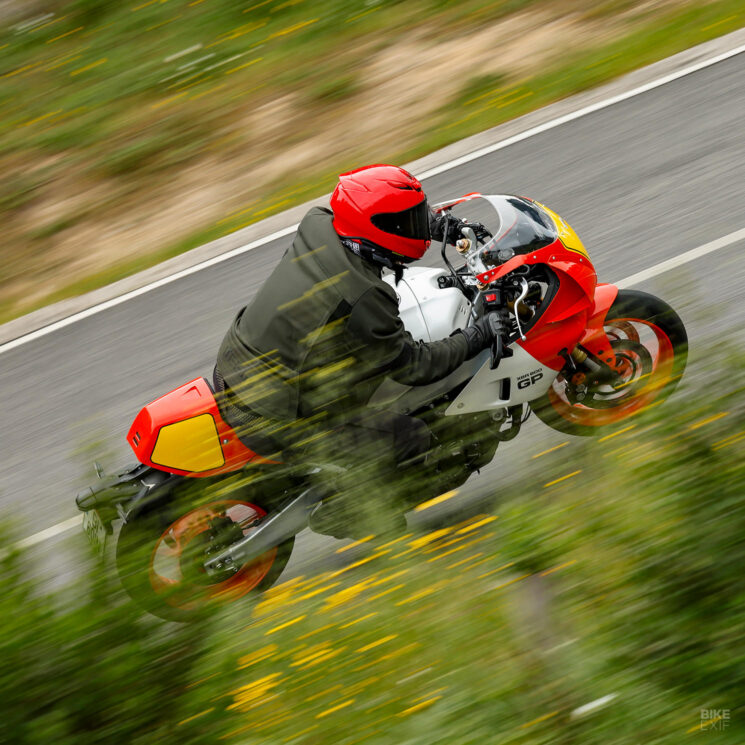
Other updates include a reinforced subframe, an extended swingarm, and a higher headstock. Those changes push the GP’s wheelbase to 1,500 mm and its trail to 110 mm, making it less nervous and more stable. The bike weighs in at 200 kilos [441 lbs] wet, with a seat height of 835 mm.
As much as the XSR900 GP’s visuals inspire memories of legendary Grand Prix racers, its capability on the road had me imagining I was one of them (even though I’m not). The crossplane engine and full-adjustable KYM suspension inspire spirited riding, and the chassis responds well to enthusiastic body English. The more gusto I rode it with, the better it got.
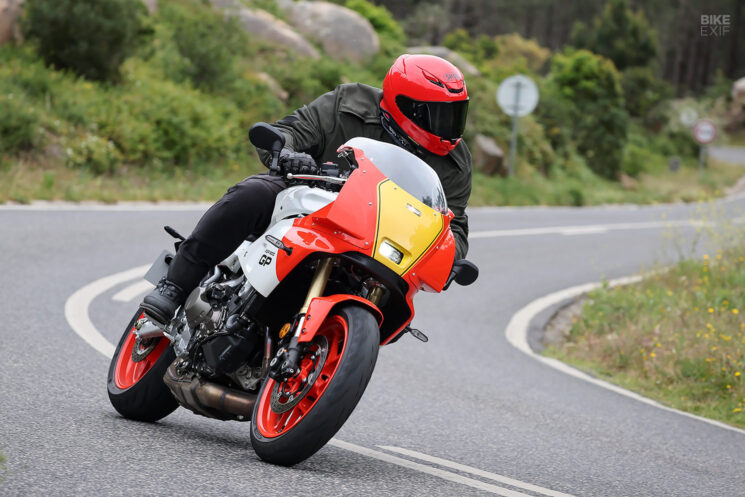
Its revised geometry does mean that the XSR900 GP relishes sweeping bends more than tight corners, but it was no slouch in either scenario.
If, like me, you prefer bikes with upright handlebars, the slightly raised clip-ons will help you adapt your riding style quickly, since they’re far less intimidating than those you’d find on more focused machines. And even though I’m a big dude for a bike this compact, I found the reach from the seat to the bars just about perfect—and the saddle gave me plenty of wiggle room to shift my weight around.
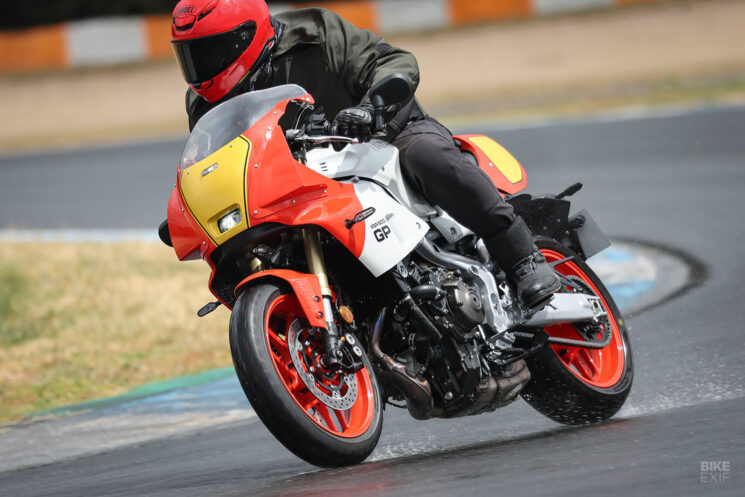
The Bridgestone Battlax S23 tires that the XSR900 GP is specced with are stellar, and did a great job of keeping me and the GP from getting bent out of shape on a damp Estoril race circuit. Likewise, the suspension kept the bike planted—even when I hit an unexpected and rather sharp bump in the road. Fiddling with the fork and shock settings would no doubt have unlocked more of their potential, but, as with the electronics, I was quite happy with how the bike was set up out of the box.
Discerning customers might pine for a swanky set of Brembo calipers on a motorcycle this stylish, but the OEM units (manufactured by Advics) are actually brilliant. Actuated by a Brembo master cylinder, the twin four-piston front calipers and 298 mm floating discs have finesse for days. Riding in the hills and during our brief time on the track, I could confidently and consistently trail brake into corners—and then utilize the XSR’s wide power band to fire out of them.
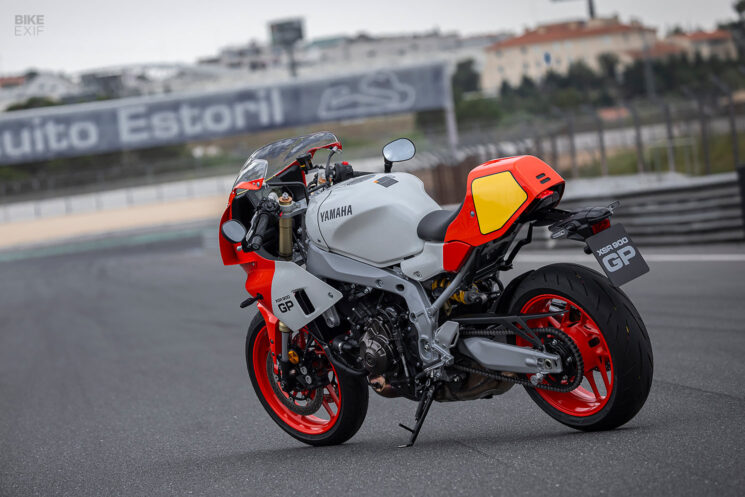
On the surface, the Yamaha XSR900 GP is a modern classic that perfectly encapsulates the era that inspired it—a bike that one passionate group fought to make a reality, even if it didn’t always make sense. On the road, it’s a superb machine that, although not billed as a sportbike, deserves the moniker.
And when you get off it, it’s a bike that’ll make you look back and smile, every damn time.
Yamaha Motor Europe | Images by Alessio Barbanti
The Yamaha XSR900 GP will be available in the UK and Europe from May 2024, with a starting price of £12,506 in the UK. There is no word on US pricing or availability yet.
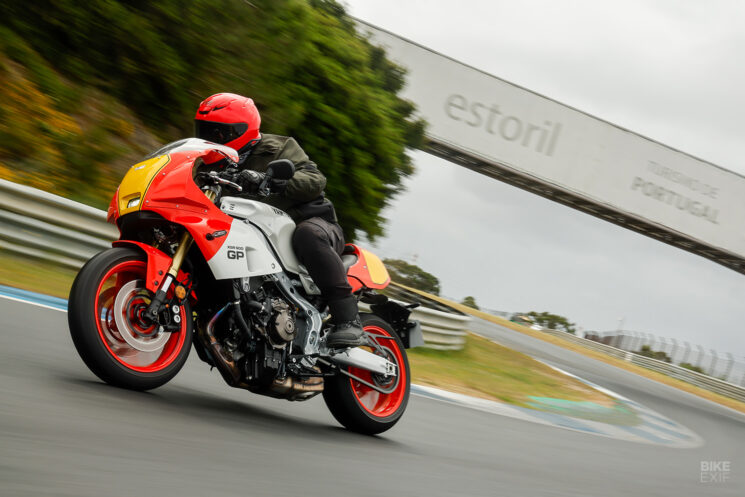
Wes’ gear Shoei NXR2 helmet, Icon Slabtown jacket, Saint Road gloves, Icon Superduty3 pants, Icon Alcan WP boots.
